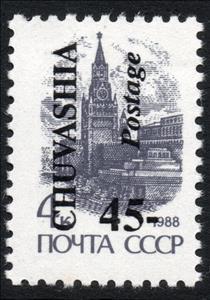Stamp: Emergency issue (Cinderellas 1993)
Emergency issue (Cinderellas 1993)
01 January (Cinderellas ) within release Chuvashia, Russia goes into circulation Stamp Emergency issue face value 45 Russian ruble
| Stamp Emergency issue in catalogues | |
|---|---|
| Colnect codes: | Col: CH 1993-02/5 |
Stamp is vertical format.
Black overprint on 4k 1988 USSR stampAlso in the issue Chuvashia, Russia:
- Stamp - Emergency issue face value 80;
- Stamp - Emergency issue face value 35;
- Stamp - Emergency issue face value 70;
- Stamp - Emergency issue face value 45;
- Stamp - Emergency issue face value 50;
- Stamp - Emergency issue face value 45;
- Stamp - Emergency issue face value 50;
- Stamp - Emergency issue face value 25;
- Stamp - Emergency issue face value 70;
- Stamp - Emergency issue face value 3;
- Stamp - Emergency issue face value 60;
- Stamp - Emergency issue face value 80;
- Stamp - Emergency issue face value 95;
- Stamp - Emergency issue face value 95;
- Stamp - Emergency issue face value 60;
- Stamp - Emergency Overprints face value 80;
- Stamp - Emergency issue face value 80;
- Stamp - Emergency issue face value 25;
- Stamp - Emergency issue face value 15;
- Stamp - Emergency issue face value 3;
- Stamp - Emergency issue face value 60;
- Stamp - Emergency issue face value 45;
- Stamp - Emergency issue face value 15;
- Stamp - Emergency issue face value 70;
- Stamp - Emergency issue face value 15;
- Stamp - Emergency issue face value 3;
- Stamp - Emergency issue face value 25;
- Stamp - Emergency issue face value 35;
- Stamp - Emergency issue face value 35;
- Stamp - Emergency issue face value 50;
Stamp Emergency issue it reflects the thematic directions:
A building or edifice is a structure with a roof and walls standing more or less permanently in one place, such as a house or factory. Buildings come in a variety of sizes, shapes and functions, and have been adapted throughout history for a wide number of factors, from building materials available, to weather conditions, to land prices, ground conditions, specific uses and aesthetic reasons. Buildings serve several needs of society – primarily as shelter from weather, security, living space, privacy, to store belongings, and to comfortably live and work. A building as a shelter represents a physical division of the human habitat (a place of comfort and safety) and the outside (a place that at times may be harsh and harmful).
A star is a luminous spheroid of plasma held together by self-gravity. The nearest star to Earth is the Sun. Many other stars are visible to the naked eye at night; their immense distances from Earth make them appear as fixed points of light. The most prominent stars have been categorised into constellations and asterisms, and many of the brightest stars have proper names. Astronomers have assembled star catalogues that identify the known stars and provide standardized stellar designations. The observable universe contains an estimated 1022 to 1024 stars. Only about 4,000 of these stars are visible to the naked eye—all within the Milky Way galaxy.
The United Nations Educational, Scientific and Cultural Organization (UNESCO; pronounced /juːˈnɛskoʊ/) is a specialized agency of the United Nations (UN) with the aim of promoting world peace and security through international cooperation in education, arts, sciences and culture. It has 194 member states and 12 associate members,as well as partners in the non-governmental, intergovernmental and private sector. Headquartered in Paris, France, UNESCO has 53 regional field offices and 199 national commissions



